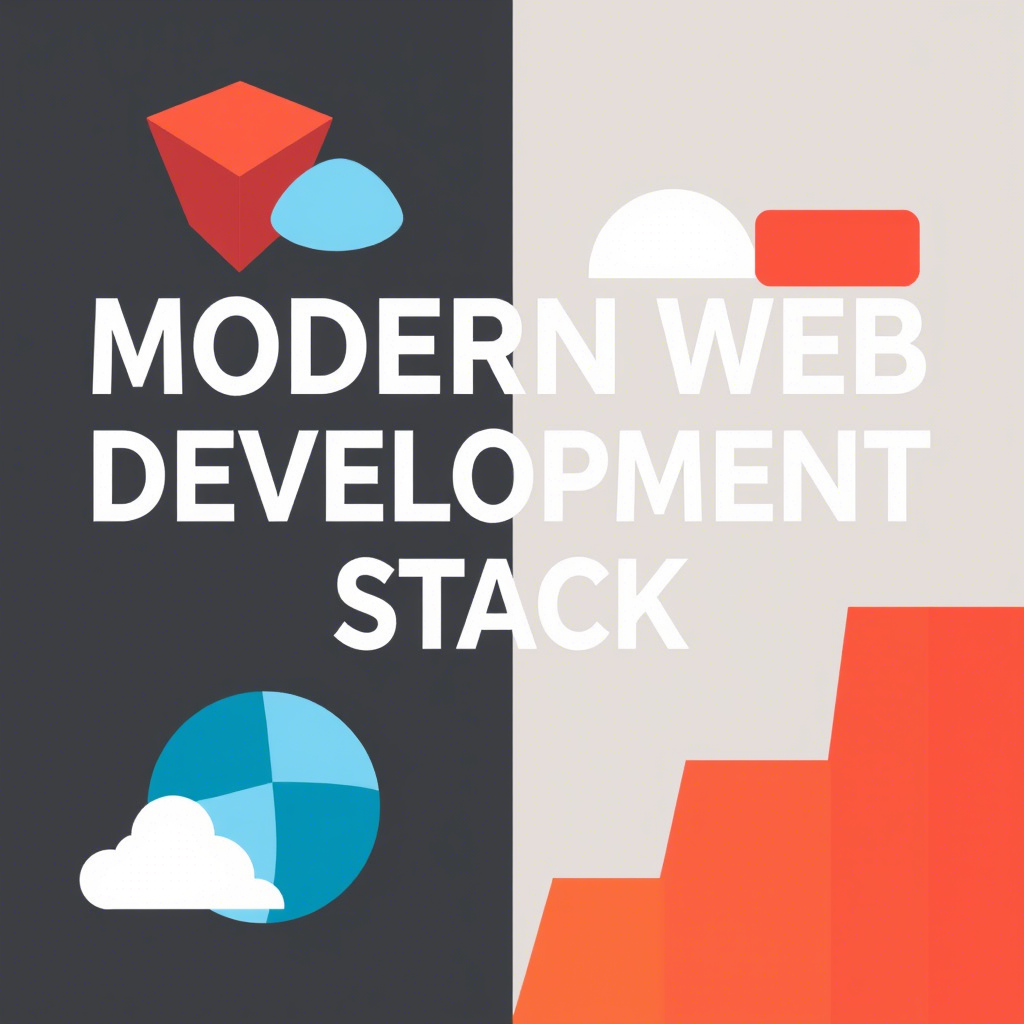Introduction: The Ever-Evolving Digital Landscape
In today’s interconnected world, the web is more than just a collection of static pages; it’s a dynamic, interactive, and often personalized experience. From complex e-commerce platforms and collaborative SaaS applications to real-time communication tools, the capabilities of modern web applications seem limitless. Behind every click, every data submission, and every seamless interaction lies a sophisticated interplay of technologies known as the “web development stack.”
For aspiring developers, seasoned professionals looking to update their skills, or even curious entrepreneurs, understanding the components of this stack is paramount. The choices made regarding frontend and backend technologies directly impact an application’s performance, scalability, maintainability, and ultimately, its success.
This article will embark on an extensive journey through the modern web development stack. We’ll dissect the fundamental concepts of frontend and backend development, explore the most popular and influential technologies in each domain, and discuss how they collaborate to bring digital visions to life. We’ll delve into the nuances of full-stack development, consider emerging trends, and provide insights to help you navigate this exciting and ever-evolving landscape. By the end of this deep dive, you’ll have a comprehensive understanding of the technological backbone that powers the contemporary web.
Part 1: Deconstructing the Web Development Stack – Core Concepts
Before we plunge into specific technologies, it’s crucial to grasp the foundational concepts that define the web development stack. At its heart, a web application is a client-server system, where the “client” is typically a web browser on a user’s device, and the “server” is a remote computer hosting the application’s logic and data.
1.1 Frontend (Client-Side) Development: The User’s Window to the Web
The frontend is everything the user directly interacts with and sees in their web browser. It’s the user interface (UI) and user experience (UX) layer. Frontend developers are responsible for the visual aspects of a website – its layout, colors, fonts, interactive elements (buttons, forms), and responsiveness across different devices.
Key responsibilities of frontend development include:
- Rendering the UI: Translating design mockups into interactive web pages.
- Handling User Input: Capturing data from forms, clicks, and other user interactions.
- Communicating with the Backend: Making requests to the server to fetch or send data.
- Client-Side Logic: Performing certain operations directly in the browser to enhance responsiveness (e.g., input validation, animation).
- Optimizing Performance: Ensuring the website loads quickly and runs smoothly.
1.2 Backend (Server-Side) Development: The Brains Behind the Operation
The backend is the server-side of the application, encompassing the server, application, and database. It’s the hidden engine that powers the frontend, handling data storage, processing requests, and executing business logic. Users don’t directly see the backend; they only experience its results through the frontend.
Key responsibilities of backend development include:
- Database Management: Storing, retrieving, and managing application data (user profiles, product information, etc.).
- API Development: Creating Application Programming Interfaces (APIs) that allow the frontend (and other services) to communicate with the backend.
- Business Logic: Implementing the core rules and operations of the application (e.g., processing orders, user authentication, data calculations).
- Security: Ensuring data integrity and protecting against unauthorized access.
- Server Management: Handling server configurations, scaling, and deployment.
1.3 Databases: The Persistence Layer
Databases are indispensable components of virtually every dynamic web application. They are organized collections of data that allow for efficient storage, retrieval, updating, and deletion of information. The choice of database often depends on the type of data, the application’s scalability requirements, and the developer’s familiarity. We’ll explore various database types later in this article.
1.4 APIs (Application Programming Interfaces): The Communication Bridge
APIs are the contract between the frontend and the backend. They define the methods and data formats that the frontend can use to request services or data from the backend, and how the backend will respond. RESTful APIs, using HTTP requests, are currently the most common standard for web communication. GraphQL is an increasingly popular alternative offering more flexibility.
Part 2: The Frontend Ecosystem – Bringing Designs to Life
The frontend landscape has seen immense innovation over the past decade. What started with simple HTML, CSS, and JavaScript has evolved into a rich ecosystem of frameworks, libraries, and tools designed to build highly interactive and maintainable user interfaces.
2.1 The Core Trio: HTML, CSS, and JavaScript
At the very foundation of every web page are three core technologies:
- HTML (HyperText Markup Language): The standard markup language for creating web pages. It provides the structure and content of the page, defining elements like headings, paragraphs, images, links, and forms.
- CSS (Cascading Style Sheets): Used for describing the presentation of a document written in HTML. CSS handles the styling – colors, fonts, layout, spacing, animations, and responsiveness. Without CSS, web pages would look like plain text documents.
- JavaScript: The programming language that makes web pages interactive. It allows for dynamic content updates, animated graphics, interactive maps, form validations, and communication with backend servers. JavaScript is the engine that brings HTML and CSS to life.
2.2 Frontend Frameworks and Libraries: Building Scalable UIs
While vanilla JavaScript is powerful, developing large, complex applications purely with it can become cumbersome. Frontend frameworks and libraries provide structured ways to build UIs, manage state, and optimize development workflows.
2.2.1 React (by Meta)
- Overview: React is a JavaScript library for building user interfaces, particularly single-page applications. It’s known for its component-based architecture, virtual DOM for efficient updates, and a declarative programming style.
- Key Features:
- Component-Based: UI is broken down into reusable components.
- Virtual DOM: Improves performance by minimizing direct DOM manipulations.
- JSX: A syntax extension for JavaScript that allows writing HTML-like code within JavaScript.
- Unidirectional Data Flow: Easier to debug and understand how data changes.
- Use Cases: Ideal for dynamic, data-driven web applications, social media feeds, complex dashboards.
- Ecosystem: Large and active community, vast ecosystem of tools (e.g., Redux for state management, React Router for navigation).
2.2.2 Angular (by Google)
- Overview: Angular is a comprehensive, opinionated framework for building large-scale, single-page enterprise applications. It comes with a full suite of tools and conventions.
- Key Features:
- TypeScript: Built with TypeScript, offering strong typing and better code organization.
- MVVM/MVC Architecture: Enforces a structured approach to application development.
- Two-Way Data Binding: Simplifies synchronization between model and view.
- CLI (Command Line Interface): Powerful tool for project creation, component generation, and development tasks.
- Use Cases: Enterprise applications, complex dashboards, highly structured SPAs.
- Ecosystem: Opinionated, provides many solutions out-of-the-box, making it easier to start big projects.
2.2.3 Vue.js
- Overview: Vue.js is a progressive JavaScript framework known for its simplicity, flexibility, and ease of adoption. It can be integrated into existing projects incrementally or used to build full-scale single-page applications.
- Key Features:
- Approachability: Easier learning curve compared to Angular or React for many developers.
- Reactivity System: Efficiently updates the DOM when data changes.
- Single-File Components: Encapsulates HTML, CSS, and JavaScript for a component in a single file.
- Progressive Adoption: Can be used for small features or entire applications.
- Use Cases: Ideal for small to medium-sized applications, interactive components within existing websites, rapid prototyping.
- Ecosystem: Growing community, good documentation.
2.2.4 Svelte
- Overview: Svelte is a radical new approach to building user interfaces. Unlike frameworks that run in the browser, Svelte is a compiler that converts your declarative components into highly optimized vanilla JavaScript at build time.
- Key Features:
- No Virtual DOM: Directly manipulates the DOM, leading to potentially smaller bundle sizes and faster runtime performance.
- Compiler-based: Less runtime overhead.
- Less Boilerplate: Often requires less code to achieve the same results.
- Use Cases: Performance-critical applications, small bundle size requirements.
- Ecosystem: Newer but gaining significant traction.
2.3 Frontend Build Tools and Package Managers
Modern frontend development heavily relies on tools that automate tasks, manage dependencies, and optimize code:
- npm (Node Package Manager) / Yarn: Package managers for JavaScript, used to install, manage, and share libraries and tools.
- Webpack / Vite / Parcel: Bundlers that combine various modules (JavaScript, CSS, images) into optimized bundles for deployment. They handle minification, transpilation (e.g., converting ES6+ to ES5 for older browsers), and asset optimization.
- Babel: A JavaScript compiler that transforms new JavaScript syntax (ES2015+) into backward-compatible versions.
- ESLint / Prettier: Linters and formatters that help enforce code consistency and identify potential errors.
Part 3: The Backend Ecosystem – Powering the Application Logic
The backend is where the heavy lifting happens: data processing, authentication, business logic, and database interactions. The choice of backend technology often depends on factors like performance requirements, developer familiarity, existing infrastructure, and scalability needs.
3.1 Backend Programming Languages and Frameworks
3.1.1 JavaScript (Node.js)
- Overview: Node.js is a JavaScript runtime environment that allows JavaScript to be used for server-side programming. This enables full-stack JavaScript development, where both frontend and backend use the same language.
- Key Features:
- Non-blocking, Event-driven I/O: Highly efficient for I/O-bound applications (e.g., real-time chat, streaming).
- Scalability: Well-suited for building scalable network applications.
- Unified Language: Reduces context switching for full-stack developers.
- Frameworks:
- Express.js: A minimalist and flexible Node.js web application framework, widely used for building APIs.
- NestJS: A progressive Node.js framework for building efficient, reliable, and scalable server-side applications, often compared to Angular for its structured approach.
- Sails.js, Koa.js: Other popular Node.js frameworks.
- Use Cases: Real-time applications (chat apps, online games), APIs, microservices, streaming platforms.
3.1.2 Python
- Overview: Python is a high-level, interpreted programming language known for its readability, simplicity, and vast ecosystem of libraries. It’s incredibly versatile and used for web development, data science, machine learning, automation, and more.
- Key Features:
- Readability: Clean syntax, making it easy to learn and use.
- Extensive Libraries: Huge collection of third-party libraries and frameworks.
- Versatility: Suitable for a wide range of applications beyond web development.
- Frameworks:
- Django: A high-level Python web framework that encourages rapid development and clean, pragmatic design. It’s “batteries-included,” providing many features out-of-the-box (ORM, admin panel, authentication).
- Flask: A lightweight and flexible micro-framework for Python, offering more freedom and less boilerplate than Django.
- FastAPI: A modern, fast (high-performance) web framework for building APIs with Python 3.7+ based on standard Python type hints. Known for its speed and automatic interactive API documentation.
- Use Cases: Complex web applications, data science applications, REST APIs, machine learning integrations.
3.1.3 Ruby
- Overview: Ruby is a dynamic, open-source programming language with a focus on simplicity and productivity. It emphasizes convention over configuration.
- Key Features:
- Developer Happiness: Designed to be a joy to use.
- Convention over Configuration: Reduces decision fatigue, promotes consistency.
- Frameworks:
- Ruby on Rails: A full-stack web application framework that follows the Model-View-Controller (MVC) architectural pattern. It heavily influenced other frameworks (like Django). Known for its speed of development.
- Use Cases: Rapid prototyping, e-commerce sites, content management systems, social networking sites.
3.1.4 PHP
- Overview: PHP is a server-side scripting language specifically designed for web development. It powers a significant portion of the internet, including WordPress.
- Key Features:
- Maturity: Long history, large community, vast resources.
- Ease of Deployment: Simple to set up on most web servers.
- Frameworks:
- Laravel: A popular, elegant PHP web framework known for its expressive syntax, robust features, and comprehensive tools (e.g., Eloquent ORM, Blade templating).
- Symfony: A high-performance PHP framework for building robust, scalable web applications, widely used in enterprise-level projects.
- CodeIgniter, Zend Framework (now Laminas): Other notable PHP frameworks.
- Use Cases: Content Management Systems (CMS), e-commerce, blogging platforms, general web applications.
3.1.5 Java
- Overview: Java is a robust, object-oriented, class-based programming language known for its “write once, run anywhere” capability and strong performance. It’s heavily used in enterprise-level applications.
- Key Features:
- Platform Independence: Runs on any platform with a Java Virtual Machine (JVM).
- Scalability & Performance: Excellent for high-performance, large-scale systems.
- Strong Typing: Helps catch errors early in development.
- Frameworks:
- Spring Boot: Built on top of the Spring framework, Spring Boot simplifies the development of production-ready Spring applications with minimal configuration.
- Jakarta EE (formerly Java EE): A set of specifications for building enterprise applications.
- Use Cases: Enterprise applications, large-scale systems, financial services, big data processing.
3.1.6 Go (Golang)
- Overview: Go is a statically typed, compiled programming language designed by Google for building simple, reliable, and efficient software. It’s known for its concurrency features.
- Key Features:
- Concurrency: Built-in support for concurrent programming using goroutines and channels.
- Performance: Compiles to machine code, offering excellent performance.
- Simplicity: Designed to be easy to read and write.
- Frameworks:
- Gin: A high-performance HTTP web framework.
- Echo: A fast and minimalist web framework.
- Use Cases: Microservices, network programming, highly concurrent systems, CLI tools.
3.2 Backend Server Environments
Once a backend application is written, it needs a server to run on.
- Apache HTTP Server: A widely used open-source web server, especially popular with PHP.
- Nginx: A high-performance web server that also functions as a reverse proxy, load balancer, and HTTP cache. Often preferred for high-traffic sites.
- Node.js built-in HTTP server: Node.js applications often include their own lightweight HTTP server.
- Cloud Servers: Virtual machines or serverless functions provided by cloud providers (AWS EC2, Azure Virtual Machines, Google Cloud Compute Engine, AWS Lambda, Azure Functions, Google Cloud Functions).
Part 4: Databases – The Persistence Layer
The data is the heart of most applications. Choosing the right database is critical for performance, scalability, and data integrity. Databases are broadly categorized into two main types: SQL (relational) and NoSQL (non-relational).
4.1 SQL (Relational) Databases
Relational databases store data in structured tables with rows and columns. They use SQL (Structured Query Language) for defining, manipulating, and querying data. They enforce schema consistency and ACID properties (Atomicity, Consistency, Isolation, Durability), making them ideal for applications requiring strong data integrity.
- MySQL: The most popular open-source relational database, widely used for web applications.
- PostgreSQL: An advanced open-source relational database known for its robustness, extensibility, and support for complex queries and data types. Often preferred for larger, more complex applications.
- SQL Server (Microsoft): A powerful relational database management system (RDBMS) for enterprise applications, especially within the Microsoft ecosystem.
- Oracle Database: A proprietary, highly scalable, and feature-rich RDBMS, primarily used by large enterprises.
4.2 NoSQL (Non-Relational) Databases
NoSQL databases provide alternative data storage and retrieval mechanisms, often designed for scalability, flexibility, and handling large volumes of unstructured or semi-structured data. They often sacrifice some ACID properties for performance and horizontal scalability.
- Document Databases: Store data in flexible, semi-structured documents (e.g., JSON, BSON).
- MongoDB: A popular open-source document database, known for its flexibility and scalability.
- Couchbase: Another document-oriented database often used for real-time applications.
- Key-Value Stores: Simple databases that store data as a collection of key-value pairs.
- Redis: An in-memory data structure store, used as a database, cache, and message broker. Excellent for high-performance caching and real-time data.
- Memcached: Another distributed memory object caching system.
- Column-Family Databases: Store data in columns, optimized for wide rows with many null values.
- Cassandra (Apache): A highly scalable, distributed NoSQL database designed to handle large amounts of data across many commodity servers.
- HBase (Apache): A non-relational, distributed database modeled after Google’s Bigtable, part of the Hadoop ecosystem.
- Graph Databases: Store data as nodes and edges, representing relationships between entities. Ideal for highly connected data.
- Neo4j: A popular graph database.
The choice between SQL and NoSQL often comes down to the specific data model, consistency requirements, and scalability needs of the application. Many modern applications use a polyglot persistence approach, combining different database types for different data needs.
Part 5: Full-Stack Development – Bridging the Gap
A full-stack developer is proficient in both frontend and backend technologies, enabling them to build a complete web application from end to end. While specialization is common, having a full-stack understanding offers significant advantages.
5.1 Benefits of Full-Stack Proficiency
- Holistic Understanding: Full-stack developers understand how all parts of an application interact, leading to more efficient design and debugging.
- Faster Prototyping: The ability to quickly build and iterate on both frontend and backend components.
- Better Communication: Can effectively communicate with both frontend and backend teams.
- Increased Versatility: Can work on different parts of a project, offering flexibility to teams.
- Career Opportunities: Highly sought after in the job market, especially for startups and smaller teams.
5.2 Popular Full-Stack Combinations (Common Stacks)
While developers can mix and match any frontend with any backend, certain combinations have become popular due to their synergy, community support, and ease of use.
-
MERN Stack:
- MongoDB (Database)
- Express.js (Backend framework for Node.js)
- React (Frontend library)
- Node.js (Backend runtime)
- Characteristics: All JavaScript, making context switching minimal. Excellent for single-page applications and real-time features.
-
MEAN Stack:
- MongoDB (Database)
- Express.js (Backend framework for Node.js)
- Angular (Frontend framework)
- Node.js (Backend runtime)
- Characteristics: Similar to MERN, but with Angular as the frontend. Favored by developers who prefer a more opinionated, structured frontend framework.
-
MEVN Stack:
- MongoDB (Database)
- Express.js (Backend framework for Node.js)
- Vue.js (Frontend framework)
- Node.js (Backend runtime)
- Characteristics: Offers the flexibility and ease of use of Vue.js with the robust backend of Node.js.
-
LAMP Stack:
- Linux (Operating System)
- Apache (Web Server)
- MySQL (Database)
- PHP (Backend language)
- Characteristics: One of the oldest and most widely used stacks. Very stable and has a huge community. Powers a significant portion of the web (e.g., WordPress). Variations include LEMP (Nginx instead of Apache).
-
Python/Django (or Flask) with React/Vue/Angular:
- Characteristics: Combines Python’s versatility and powerful backend capabilities with modern, interactive JavaScript frontends. A very popular choice for data-intensive applications and APIs.
-
Ruby on Rails with React/Vue/Angular:
- Characteristics: Leverages Rails’ rapid development capabilities with a modern frontend framework for rich user experiences.
Part 6: Beyond the Core Stack – Supporting Technologies and Practices
Building a successful web application involves more than just selecting frontend and backend technologies and a database. Several other components and practices are essential for development, deployment, and maintenance.
6.1 Version Control Systems (VCS)
- Git: The undisputed standard for version control. It tracks changes in code, allows collaboration among multiple developers, and enables easy rollback to previous versions. Platforms like GitHub, GitLab, and Bitbucket provide cloud-based hosting and collaboration features for Git repositories.
6.2 Deployment and Hosting
Once an application is built, it needs to be deployed to a server so users can access it.
- Cloud Platforms:
- AWS (Amazon Web Services): Offers a vast array of services for computing (EC2, Lambda), databases (RDS, DynamoDB), storage (S3), networking, and more.
- Microsoft Azure: Microsoft’s cloud computing platform, offering similar services to AWS.
- Google Cloud Platform (GCP): Google’s suite of cloud computing services.
- PaaS (Platform as a Service): Simplified deployment and scaling by abstracting underlying infrastructure.
- Heroku: Popular for ease of deployment, especially for smaller to medium-sized applications.
- Vercel / Netlify: Specialized in frontend deployment, particularly for static sites and serverless functions (often used with Next.js, Nuxt.js, etc.).
- Containerization (Docker & Kubernetes):
- Docker: Allows packaging applications and their dependencies into portable “containers,” ensuring consistency across different environments.
- Kubernetes: An open-source system for automating deployment, scaling, and management of containerized applications. Essential for microservices architectures and large-scale deployments.
6.3 CI/CD (Continuous Integration/Continuous Deployment)
- CI/CD Pipelines: Automate the processes of building, testing, and deploying code changes. Tools like Jenkins, GitLab CI/CD, GitHub Actions, and CircleCI enable developers to integrate changes frequently, test them thoroughly, and deploy them rapidly, reducing errors and improving development velocity.
6.4 Testing
Robust testing is crucial for ensuring the quality and reliability of web applications.
- Unit Tests: Test individual components or functions in isolation.
- Integration Tests: Verify that different parts of the application work together correctly.
- End-to-End (E2E) Tests: Simulate user interactions with the entire application from start to finish.
- Tools: Jest, Cypress, Playwright, Selenium.
6.5 Web Security Best Practices
Security must be an integral part of the development process, not an afterthought.
- HTTPS: Encrypts communication between the browser and server.
- Input Validation: Preventing SQL injection, XSS (Cross-Site Scripting), and other injection attacks.
- Authentication and Authorization: Securely managing user identities and permissions.
- Rate Limiting: Protecting against brute-force attacks and abuse.
- Regular Security Audits: Identifying and mitigating vulnerabilities.
Part 7: Emerging Trends and Future Directions
The web development landscape is dynamic, with new technologies and methodologies constantly emerging. Staying abreast of these trends is vital for long-term success.
7.1 Serverless Computing
- Concept: Allows developers to write and deploy code without managing servers. The cloud provider automatically provisions and scales the necessary infrastructure.
- Benefits: Reduced operational overhead, pay-per-use billing, automatic scaling.
- Examples: AWS Lambda, Azure Functions, Google Cloud Functions.
- Impact: Reshaping backend development, especially for microservices and event-driven architectures.
7.2 WebAssembly (Wasm)
- Concept: A low-level binary instruction format for a stack-based virtual machine. It allows high-performance code written in languages like C++, Rust, or Go to run directly in the browser at near-native speeds.
- Impact: Enables performance-intensive applications (e.g., games, video editing, CAD) to run efficiently in the browser, potentially expanding the capabilities of web applications significantly.
7.3 Jamstack
- Concept: An architectural approach for building websites and applications that focuses on JavaScript, APIs, and Markup. It emphasizes pre-rendering static content, leveraging CDNs, and interacting with dynamic data via APIs.
- Benefits: Enhanced performance, better security, lower scaling costs, simplified development.
- Tools: Static site generators (Gatsby, Next.js, Nuxt.js), headless CMS (Strapi, Contentful), cloud functions.
- Impact: A shift towards faster, more secure, and scalable web experiences, particularly for content-heavy sites and e-commerce.
7.4 Headless CMS and API-First Development
- Concept: Decoupling the content management system (CMS) from the frontend presentation layer. The CMS provides content via APIs, and any frontend can consume it.
- Benefits: Greater flexibility in frontend choice, omnichannel content delivery, improved developer experience.
- Examples: Strapi, Contentful, Sanity, Prismic.
7.5 AI and Machine Learning Integration
- Concept: Integrating AI and ML capabilities directly into web applications for features like personalized recommendations, intelligent search, chatbots, content generation, and data analysis.
- Tools: TensorFlow.js (for client-side ML), various cloud ML APIs (Google Cloud AI, AWS AI Services, Azure Cognitive Services).
- Impact: Making web applications smarter and more intuitive.
Conclusion: Navigating the Landscape and Building for the Future
The modern web development stack is a rich and complex tapestry of technologies, constantly evolving to meet the demands of an increasingly digital world. From the visual artistry of frontend frameworks to the robust logic of backend languages and the intricate efficiency of databases, each component plays a vital role in crafting the seamless online experiences we’ve come to expect.
Understanding these interconnected pieces is not just about mastering individual technologies; it’s about comprehending their interplay, recognizing their strengths and weaknesses, and making informed decisions that align with project requirements and future scalability. Whether you choose to specialize as a frontend or backend expert, or embrace the versatility of full-stack development, a foundational knowledge of the entire stack is invaluable.
As technology continues to accelerate, the lines between different layers of the stack may blur further, and new paradigms like serverless computing and WebAssembly will become more mainstream. The key to thriving in this environment is continuous learning, adaptability, and a passion for building innovative solutions. By staying curious, experimenting with new tools, and focusing on user value, developers can continue to push the boundaries of what’s possible on the web, shaping the digital future one line of code at a time. The journey into the modern web development stack is an ongoing adventure, full of discovery and endless possibilities.



